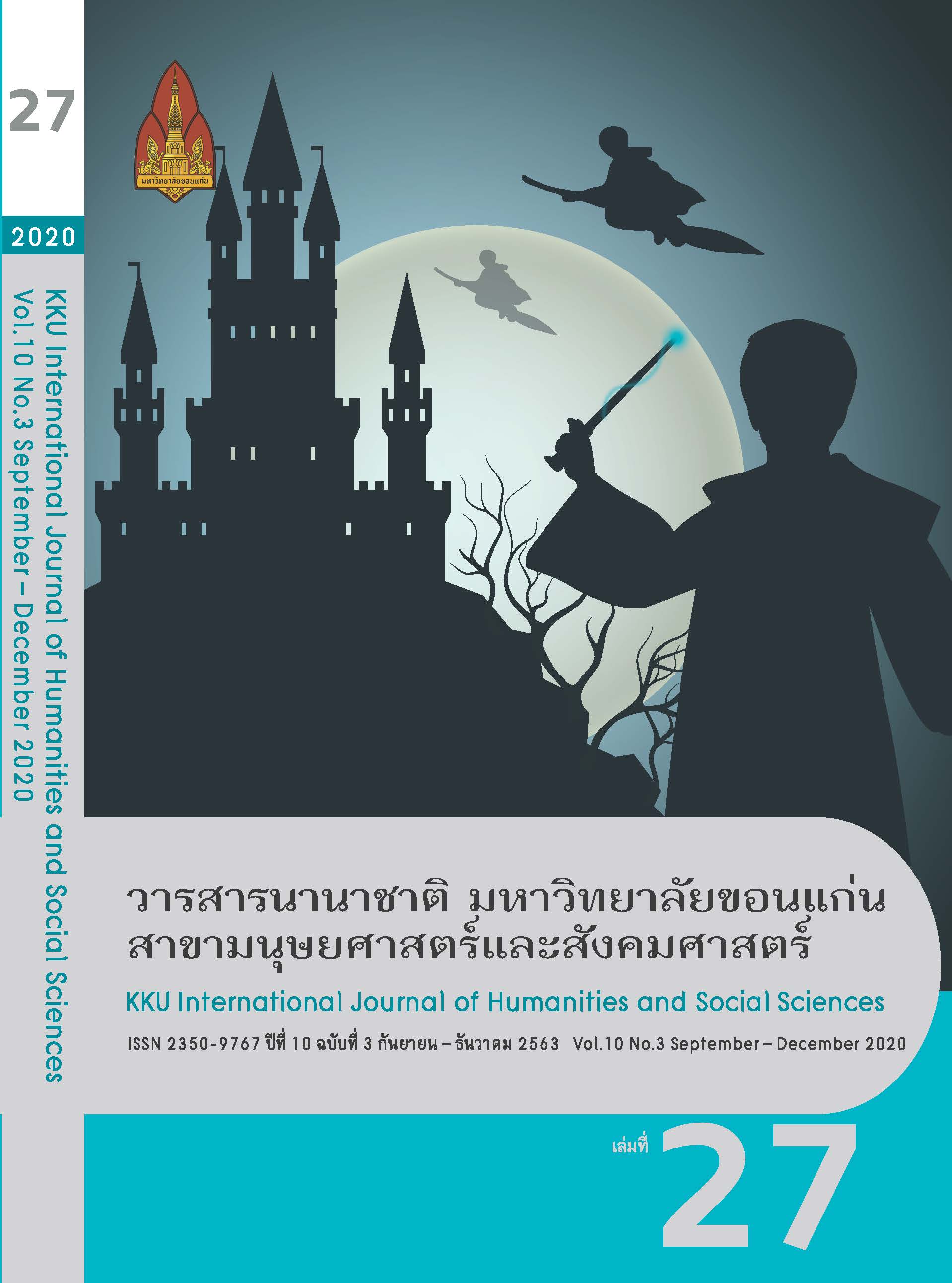Exploring Properties of Quadrilaterals in Elliptic Geometry using the Dynamic Geometry Software
Main Article Content
Abstract
The purpose of this research was to study students’ exploring the important properties of Elliptic quadrilaterals using the Dynamic Geometry Software (DGS). The participants comprised 26 mathematics students in the fourth year of their undergraduate program in the Faculty of Education at Rajabhat Rajanagarindra University, Thailand. They had enrolled in the Foundations of Geometry course at the first semester of the academic year 2019. The instruments were activity packages exploring properties of Saccheri and Lambert quadrilaterals in elliptic geometry using DGS. The results indicated that the students could make conjectures and verify properties of elliptic quadrilaterals correctly and rapidly. The students concluded that the summit angles in a Saccheri quadrilateral are always congruent and obtuse. The line joining the midpoints of the base and summit of a Saccheri quadrilateral is perpendicular to both the base and the summit. They also concluded that in elliptic geometry, a Lambert quadrilateral has its fourth angle obtuse, and each side of this angle is shorter than the side opposite. Therefore, the use of DGS can help students visualize this non-Euclidean geometry.
Article Details
References
Bhagat, K. & Chang, C. (2015). Incorporating GeoGebra into geometry learning–A lesson from India, Eurasia Journal of Mathematics, Science & Technology Education, 11(1), 77–86.
Bielefeld, T. (2002) On dynamic geometry software in the regular classroom, Zentralblattfür Didaktikder Mathematik, 34(3), 85–92.
Buda, J. (2017). Integrating Non-Euclidean Geometry into High School. Honors Thesis, Loyola Marymounth University.
Dogan, M. & Icel, R. (2011). The role of Dynamic Geometry Software in the process of learning: GeoGebra example about triangles, International Journal of Human Science, 8(1), 1441–1458.
Dolbilin, N. (2004). Geometry in Russian Schools: Traditions of Past and State in Present. In Hiroshi F, Yoshihiko H, Bernard H, Peng L, Stephen L, Toshio S. (Eds.), Proceedings of the Ninth International Congress on Mathematical Education. Boston: Kluwer Academic Publishers, 118–120.
Erbas, A. & Yenmez, A. (2011). The effect of inquiry-based explorations in a dynamic geometry environment on sixth grade students’ achievements in polygons, Computers & Education, 57(4), 2462–2475.
Goldenberg, P. & Couco, D. (1998). What is dynamic geometry? In Richard L, Daniel C. (Eds), Designing Learning Environments for Developing Understanding of Geometry and Space. London: Lawrence Erlbaum Associates Publishers, 351–367.
Groman, M. (1996) Integrating Geometer’s Sketchpad into a Geometry Course for Secondary Education Mathematics Majors. In Peter S. (Ed.), Association of Small Computer Users in Education (ASCUE) Summer Conference Proceedings. North Myrtle Beach, SC, 61–65.
Guven, B. & Karatas, I. (2009). Students discovering spherical geometry using dynamic geometry software, International Journal of Mathematical Education in Science and Technology, 40(3), 331–340.
Guven, B. (2012) Using dynamic geometry software to improve eight grade students’ understanding of transformation geometry, Australasian Journal of Educational Technology, 28(2), 364–382.
Hvidsten, M. (2005). Geometry with Geometry Explorer. New York: McGraw–Hill.
Hvidsten, M. (2017). Exploring Geometry (2nd ed). Boca Raton, Florida: Taylor & Francis Group.
Kurtuluş, A. & Ada, T. (2011). Exploration of geometry by prospective mathematics teachers in Turkey with Geometer’s Sketchpad, Quaderni di Ricerca in Didattica (Mathematics), 21, 119–126.
Lezark, L. & Capaldi, M. (2016). New findings in old geometry: Using triangle centers to create similar or congruent triangles, The Minnesota Journal of Undergraduate Mathematics, 2(1), 1–12.
Lorsong, K. & Singmuang, C. (2015). A development of mathematics learning achievement entitled angle for Prathomsuksa 5 students using the Geometer’s Sketchpad (GSP) laboratory lessons, Proceedings International Academic & Research Conference of Rajabhat University: INARCRU III. Nakhon Si Thammarat, Thailand: Nakhon Si Thammarat Rajabhat University, 134–142.
Merzbach, U.M. & Boyer, C. (2011). A History of Mathematics (3rd ed). Hoboken, New Jersey: John Wiley & Sons, Inc.
Schoenfeld, A. (1986). On having and using geometric knowledge. In James H. (Ed.), Conceptual and Procedural Knowledge: The Case of Mathematics. Hillsdale, NJ: Lawrence Erlbaum Associates, Inc., 225–264.
Sebial, S. (2017). Improving mathematics achievement and attitude of the grade 10 students using Dynamic Geometry Software (DGS) and Computer Algebra Systems (CAS), International Journal of Social Science and Humanities Research, 5(1), 374–387.
Singmuang, C. & Phahanich, W. (2004). The Use of Computer Program in Learning and Teaching Introduction to Geometry Course. Faculty of Science and Technology, Rajabhat Rajanagarindra University.
Singmuang, C. (2013). Preservice mathematics teachers discovering spherical geometry using dynamic geometry software. Proceedings National Academic Conference “Research Network for Higher Education of Thailand”. Nakhon Pathom, Thailand: Research Network for Higher Education of Thailand, 218–231.
Singmuang, C. (2016). Exploring triangle centers in Euclidean geometry with the Geometry Explorer. Proceedings of the Asian Conference on the Social Sciences. Kobe, Japan: The International Academic Forum, 289–298.
-------. (2018). Exploring properties of quadrilaterals in the Poincaré Disk model of hyperbolic geometry using the Dynamic Geometry Software, Journal of Strategic Innovation and Sustainability, 13(3), 129–142.
Smart, J. (1998). Modern Geometry (5th ed). California: Brook/Cole.
Smith, R., Hollebrands, K., Iwancio, K. & Kogan, I. (2007). The affects of a dynamic program for geometry on college students’ understandings of properties of quadrilaterals in the Poincare Disk model. In David P, Alan R, Amélie S. (Eds.), Proceedings of the Ninth International Conference on Mathematics Education in a Global Community, 2007: 613–618. Charlotte, NC: The University of North Carolina Charlotte.
Straesser, R. (2002). Cabri–geometre: Does dynamic geometry software (DGS) change geometry and its teaching and learning?, International Journal of Computers for Mathematical Learning, 6(3), 319–334.
Venema, G. (2003). Exploring Advanced Euclidean Geometry with GeoGebra. Washington, DC: The Mathematical Association of America.


